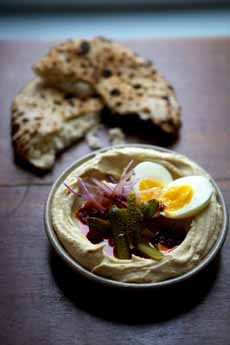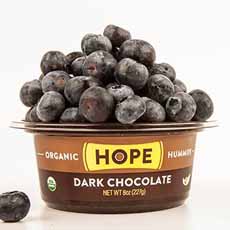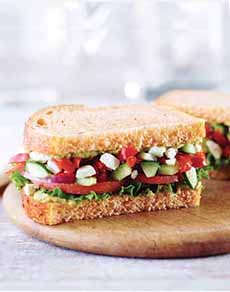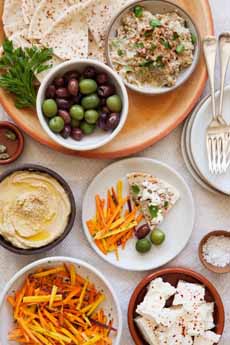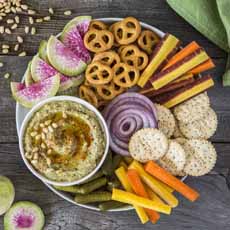It’s International Hummus Day: Try A New Brand Like Hope Foods
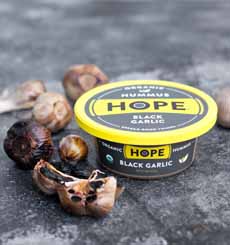 [1] Black Garlic, one of 11 delicious flavors of Hope Hummus (photos #1 and #3 © Hope Foods).
|
May 13th is International Hummus Day. Over the last two decades, hummus has evolved from a mezze at Mediterranean restaurants to the hottest, most nutritious dip and spread at supermarkets nationwide. It’s the darling of nutritionists, nutritious and versatile, and a better-for-you snack. Hummus is Arabic for chickpeas. The more long-form name for what we refer to as hummus is hummus bi tahina, chickpeas with tahini. Tahini is a paste made of toasted, hulled sesame seeds, which can be joyed as a dip on its own. The recipe for hummus is simple: chickpeas, tahini, and seasonings (including garlic), mashed and puréed*. > The history of hummus is below. > So are 18 delicious hummus recipes. > What are mezze? Two decades ago, the hummus available in the U.S. was the classic: plain. If you didn’t order it at a restaurant or live near a neighborhood with an international market that carried it, you made your own the recipe is easy, once you found a store with tahini). But since the hummus renaissance, stores have been sagging under the weight of so many brands and so many flavors. We’ve counted more than two dozen flavors among different brands. Our two personal favorites are horseradish and black olive, which we found at Trader Joe’s. But, we like everything. So we were very pleased to receive samples of a new brand from Hope Foods. If you head to the website now, you can enter to win a year’s supply of hummus. There are 11 flavors of hummus. We tried three of them, all especially delicious. First, the consistency is wonderful, like well-mashed homemade hummus. While we enjoy the ultra-smooth texture of big brands like Tribe, we welcome the return of toothsome texture, like Grandma used to make (if your grandma’s ancestry was in the eastern Mediterranean). Second, the flavor selection is a bit more interesting, with black garlic, Thai coconut curry, and spicy avocado hummus (the most popular flavor). The line is preservative-free, certified Gluten-Free, Non-GMO Certified, OU kosher, and USDA Organic. There’s a store locator on the website. Currently, the line of hummus includes: The company also makes guacamole, which we look forward to trying. “Spread” the word! |
|
|
THE HISTORY OF HUMMUS Chickpeas, sesame, lemon, and garlic have been eaten in the Levant† for millennia. Though widely consumed, chickpeas were cooked in stews and other hot dishes. Puréed chickpeas eaten cold with tahini do not appear before the Abbasid period (750 to 1517 C.E.) in Egypt and the Levant. The earliest known recipes for a dish similar to hummus bi tahina appear in 13th-century cookbooks from Cairo. Some food historians believe the dish appeared a century earlier, prepared by Saladin, the first sultan of the Ayyubid dynasty (1174–1193). (If so, it was more likely created by a cook in Saladin’s kitchen, the idea of the warlord Saladin-as-cook being tough to swallow.) Recipes for cold purée of chickpeas without tahini, but with vinegar, oil, pickled lemons, herbs, and spices (but no garlic), appear in medieval cookbooks; as do recipes with nuts vinegar (though not lemon), with many spices and herbs. [source] Whomever and however, we’re grateful that it came to be part of our [almost] daily diet, ________________ †The Levant is an English term that first appeared in 1497. It originally referred to the “Mediterranean lands east of Italy.” The historical area comprises modern-day Iraq, Israel, Jordan, Lebanon, Palestine, and Syria. Among other popular foods, Levantine cuisine gave birth to baklava, falafel, kebabs, mezze (including tabbouleh, hummus, and baba ghanoush), pita and za’atar, among other dishes that are enjoyed in the U.S. and around the world. Mezze (MEH-zay) or meze is the singular form for a number of small dishes served in the Middle East to accompany drinks (add an “s” for the plural form in English). In some countries, an assorted mezze plate is served as an appetizer. Each country has its favorites. The ones most often found in the U.S. are: |
|
|
|
|
||
